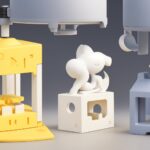How 3D Printing is Transforming Manufacturing, Medicine, and Art
### **How 3D Printing is Transforming Manufacturing, Medicine, and Art**
**3D printing** has revolutionized numerous industries by offering unprecedented levels of customization, efficiency, and creativity. This technology, once primarily used for prototyping, is now being applied across a wide range of fields, from **manufacturing** to **medicine** and **art**. In this article, we’ll explore the most impactful **applications of 3D printing** in these key industries and how it is transforming traditional processes.
#### **3D Printing in Manufacturing**
The **manufacturing industry** was one of the earliest adopters of **3D printing** technology, and its impact continues to grow.
– **Rapid Prototyping**: One of the primary benefits of **3D printing in manufacturing** is the ability to quickly create prototypes. Engineers and designers can now produce a physical model of a product within hours, allowing for rapid iterations and testing. This significantly shortens the product development cycle.
– **Example**: Automotive companies like Ford use **3D printing** to create car parts and components during the design phase, accelerating the development process.
– **Customization and On-Demand Production**: **3D printing** enables manufacturers to produce highly customized products, from consumer goods to industrial tools. Unlike traditional manufacturing methods that require molds and expensive setups, **3D printing** can produce one-off items with no additional costs.
– **Example**: Nike has used **3D printing** to create customized footwear and prototypes for its latest shoe designs, offering consumers more personalized products.
– **Reduced Waste**: Traditional manufacturing methods often result in a significant amount of material waste. However, **3D printing** is an additive process, meaning materials are only used where needed, reducing waste and optimizing resource use.
– **Example**: Aerospace companies like GE Aviation use **3D printing** to produce lightweight, fuel-efficient engine parts with minimal material waste.
#### **3D Printing in Medicine**
The impact of **3D printing in medicine** is profound, offering new possibilities in patient care, surgical planning, and the development of medical devices.
– **Custom Implants and Prosthetics**: One of the most significant advancements in **medical 3D printing** is the ability to create custom-made implants and prosthetics. Because **3D printing** can produce highly accurate, patient-specific models, it allows for better-fitting, more comfortable medical devices.
– **Example**: 3D-printed titanium implants are now being used in orthopedic surgeries to replace damaged bones or joints. Custom prosthetic limbs are also being produced at a lower cost and with a quicker turnaround.
– **Surgical Planning and Training**: **3D printing** is also used to create highly accurate anatomical models, helping surgeons plan complex procedures. These models allow for better visualization and practice before actual surgeries, improving outcomes and reducing the risk of complications.
– **Example**: Surgeons at hospitals like the Mayo Clinic use **3D-printed models** of organs, such as hearts or kidneys, to plan for surgeries, especially in complicated cases like congenital deformities.
– **Bioprinting**: In the field of **bioprinting**, researchers are using **3D printing** technology to create tissues and organs from living cells. While still in the experimental stage, bioprinting holds the promise of revolutionizing organ transplants and regenerative medicine.
– **Example**: Scientists have successfully 3D-printed skin, cartilage, and even small liver tissue, raising hope for future organ replacement therapies.
#### **3D Printing in Art and Design**
The world of **art and design** has embraced **3D printing** for its ability to push creative boundaries and offer unique customization options.
– **Sculpture and Installations**: Artists use **3D printing** to create intricate sculptures and installations that would be nearly impossible to produce with traditional techniques. The technology allows for complex geometric designs, precise details, and the ability to work with a variety of materials.
– **Example**: Artist Joshua Harker, known for his intricate 3D-printed skulls, has pioneered a new style of digital sculpture made possible by **3D printing**.
– **Fashion and Jewelry**: **3D printing** has found a niche in fashion and jewelry design, allowing for the creation of bespoke, avant-garde pieces. Designers can experiment with materials like plastics, metals, and even fabrics, creating unique wearable art.
– **Example**: Fashion designer Iris van Herpen uses **3D printing** to create stunning, futuristic dresses and accessories that have been featured on runways worldwide.
– **Customization in Interior Design**: In interior design, **3D printing** allows for highly customized furniture, lighting, and decorative elements that can be tailored to specific spaces and client preferences.
– **Example**: Designers are using **3D printing** to produce everything from unique lamp shades to fully customized furniture pieces, offering endless possibilities for personalization.
#### **Future of 3D Printing in Various Industries**
As **3D printing** technology advances, its applications will continue to expand. In manufacturing, **3D printing** will further streamline production processes, reduce costs, and allow for even more complex, high-performance materials. In medicine, breakthroughs in **bioprinting** could lead to the printing of fully functional organs. Artists and designers will continue to push the limits of creativity, using **3D printing** as a medium for new forms of expression.
#### **Conclusion**
The transformative power of **3D printing** is evident across a wide range of industries, from **manufacturing** and **medicine** to **art** and design. As the technology evolves, its applications will continue to grow, offering new opportunities for innovation, customization, and sustainability. Whether it’s improving patient outcomes, creating cutting-edge fashion, or optimizing industrial production, **3D printing** is reshaping the way we approach design and fabrication in profound ways.



